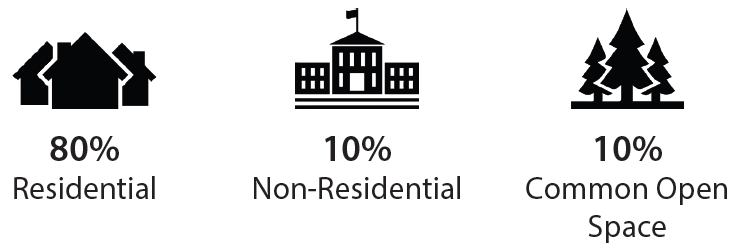Place Types - Neighborhood 1
Place Types - Neighborhood 1
Place Types are a classification of land that provides guidance for how future development should look and function. They describe types and intensities of land use as well as important characteristics such as scale, site design, and accessibility. These draft policies will be reviewed by staff and the community, with a final draft document anticipated in Fall 2018. You are reviewing Neighborhood 1, one of 14 different Place Types. Thank you for your time and interest in shaping the future of our community.
DRAFT Document - Neighborhood 1
Click this link to open a full copy of Place Types - Neighborhood 1.
You'll need this for reference as you take the survey.
Summary
(Sidebar on right side of document)
This section summarizes the intent and rataionale for the "building blocks" of Place Types. These "building blocks" range from Land Use to Transportation.
Please share any questions/comments you have on the following "building blocks".
Goals
- Protect established character and provide opportunity for a variety of housing types.
- Integrate Neighborhood 1 into surrounding Neighborhood Place Types to develop complete neighborhoods.
Land Use
- Neighborhood 1 is a predominately residential neighborhood that may also include some civic and institutional uses.
- The predominant types of open spaces are private yards which helps create a sense of privacy that is unique to this Place Type. Neighborhood parks may also be located in Neighborhood 1.
Urban Design
- This place is characterized by uniform rhythm and pattern along the street which is established by having one principal building per lot.
- Buildings are placed at a consistent distance from the street and from each other.\
- Buildings are low-rise and are made up of predominately detached houses, with some detached accessory dwelling units, and duplex, triplex, and quadraplex houses.
Transportation
- The local street network within Neighborhood 1 should be well connected in order to provide adequate access and help disperse traffic. The network should accommodate pedestrians, bicyclists, and automobiles.
- Arterial Streets traversing this place should be designed to allow safe and comfortable bicycle and pedestrian travel between the neighborhood and nearby destinations.
Elements
(Items starting at lower left corner of document, eg. Typical Mix of Uses)
This section further refines the "building blocks" mentioned in the Summary. These city-building characteristics range from Building Size to Sidewalks and vary from Place Type to Place Type.
Typical Mix of Uses
Zoning Districts
- This place has a range of zoning districts that acknowledge the diverse character of the neighborhoods in Charlotte. In historic districts, tearing down contributing structures is always discouraged.
- Specific Zoning Districts will be developed for this Place Type and included here.
Building Types
- A variety of building types provides a range of housing choices and is critical to accommodating our community’s diverse population.
- Primary building types are detached houses and duplexes.
- Lots in Neighborhood 1 may also have accessory dwelling units and detached garages in the rear yard.
- Triplexes and quadraplexes may be located on corner lots.
- Non-residential buildings for civic and institutional uses are typically located on Arterial Streets, on corners, and at the edges of neighborhoods.
Building Size
- Building sizes throughout Neighborhood 1 are typically a low scale to maintain the character of a residential neighborhood.
- Residential buildings will vary in size.
- Nonresidential buildings are typically less than 10,000 square feet.
- The sizes of civic and institutional buildings vary based on context and accessibility.
Building Length Along the Street Frontage
- The length of residential buildings will vary, but are typically relatively consistent along a block.
- The length of non-residential civic and institutional buildings will vary based on the context of the area.
Building Height
- Buildings in Neighborhood 1 are typically low rise and that helps create a human scale in this place.
- Typical height is under 3 stories in Neighborhood 1.
- Appropriate height transition is important for maintaining the character of a neighborhood and can be addressed by maintaining similar roof height to adjacent buildings.
Yards
- Yards help define the uniform rhythm and pattern along a street.
- The size of front and side yards vary across neighborhoods but is consistent within a neighborhood.
- The front yard establishes the front setback and should be consistent along a street.
- The front yard is semi-private open space for a residential property.
- Side yards establish relatively consistent spacing of buildings along a street.
Orientation
- Consistent orientation along a street front helps create a strong public realm.
- Principal buildings are oriented toward the street.
- Multi-unit buildings (duplex, triplex, quadraplex) on corner lots are encouraged to have entrances that front on both streets.
- Buildings should not be oriented toward a driveway or alley.
Building Relationship to Local Streets
- Most buildings in Neighborhood 1 are located along Local Streets.
- Buildings typically have fairly deep front yards, with buildings typically placed around 20-50 feet from the street.
Building Relationship to Arterial Streets
- Residences should be set further from the street on Arterial Streets compared to Local Streets to reduce noise or other traffic impacts.
- In some cases, an internal street network may be established and enable reverse orientation to the Arterial Street.
Building Coverage and Impervious Surface
- Low to moderate building and impervious coverage help ensure Neighborhood 1 has plenty of open space which is important for multiple environmental and recreational purposes.
- Total impervious surface should make up less than half of Neighborhood 1 lots, typically less than 30%.
Open Space and Yards
- Private yards comprise much of the open space areas.
- Trees planted within yards significantly contribute toward the City’s tree canopy.
- Neighborhood parks, common open spaces, and greenways should also be located within Neighborhood 1.
Connectivity
- A goal of connectivity is to stitch together a street network that supports trips made by walking, biking, and driving.
- A connected street network increases accessibility throughout a neighborhood to homes and services. Generally, shorter blocks enable more route choices and promote walkability.
- Block lengths are typically 400’-600’ in urban (infill) locations.
- Block lengths are typically 600’-800’ in suburban (or greenfield) locations.
Pedestrian Network
- The pedestrian network provides safe, comfortable transportation and recreation choices for residents that connect homes and destinations.
- Sidewalks should be installed in new neighborhoods and are desired in existing neighborhood without sidewalks today.
- The pedestrian network should include off-street connections from streets to adjacent greenways, parks, schools, and other streets where possible.
Parking
- Parking should be located to the side or rear of the primary structure.
- On-street parking is provided along Local Streets where there is adequate street width, but is atypical on Arterial Streets in Neighborhood 1.
Vehicular Access
- Driveways are typically accessed off of Local Streets through individual driveways, but shared driveways are also appropriate and encouraged because they reduce conflicts for pedestrians and bicyclists.
- For new development, alleys are encouraged because they provide access and parking for residents and reduce driveways along the street (critical with Narrow Local Streets except within very large lot development, encouraged with Medium and Wide Local Streets).
Streets
- Neighborhood 1 consists mainly of Local Streets, typically the Medium Local Residential type (see general provisions, P. XX, for conditions that require/allow other Local Street Types).
- Target speeds should be low (maximum 25 mph on internal streets, XX mph on Arterial Streets).
Sidewalks
- Sidewalks enable safe access throughout the neighborhood.
- Should be a minimum of 6’ wide (unobstructed) on Arterial Streets.
- Should be a minimum of 5’ wide (unobstructed) on Local Streets.
- Connections should be provided between the sidewalk and residences or other uses.
Green Zone
- The Green Zone is typically no less than 8’ wide to accommodate shade trees, grass, and/or hardscape elements. It provides separation between pedestrians and vehicles, helps calm traffic, provides an attractive public realm, contributes to the City’s healthy tree canopy, and shades the streets and users.
- In most areas of Neighborhood 1, a grassed or vegetated planting strip is appropriate.
- In areas of Neighborhood 1 that are more urban and transitioning or adjacent to Neighborhood Nodes, a hardscaped amenity area is encouraged in lieu of a planting strip.
Bicycle Facilities
- Dedicated bike facilities are expected on Arterial Streets due to higher speeds and volumes.
- Cyclists sharing lanes with vehicles is typical on internal Local Streets, since speeds and traffic volumes should be low.
- Design of the bicycle facility varies (see general provisions, p. XX, for factors influencing bike facilities).
Street Furnishings
- If provided, street furnishings should be located in the Green Zone to keep the sidewalk unobstructed.
- Bus stops located in or near neighborhoods should be accessible via a sidewalk and ideally include a shelter, benches, and/or trash receptacles.

